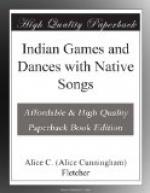The netted hoop appears as a decoration upon the interior of pottery bowls formerly made by the Indians of the Southwest. In some of these bowls the netting is dotted with spots. Dr. Culin regards this particular design “as representing the spider web with the dew upon it,” and adds: “The ’water shield’ [of one of the Zuni War Gods], from which he shook the torrents, was suggested, no doubt, by dew on the web.” (Ibid., p.425.) To one unfamiliar with the Indian’s habit of mind it may seem strained to connect the beads of dew on a spider’s web with the torrential rain, but to one familiar with native thought as expressed in myths where the Indian has dramatized his conceptions of nature and of natural forces and phenomena, the connection ceases to be strange.
On the Pueblo altars the netted shield is always associated with arrows, bows or darts. In the various types of this game the arrows, darts, bows, javelins and lances that are associated with the hoop are interchangeable, some tribes using one and other tribes another. Under all the varied types with their different forms as found among scattered and unrelated tribes the game holds to its original significance, primarily religious in character, being an appeal for the protection and the perpetuity of life.
Only two articles are required for this game, the hoop and the javelin. In one type the hoop is covered with a netting more or less closely and elaborately woven. In all the netted designs it is usually possible to trace a figure as of a path crossing at right angles in the center of the space within the hoop and ending at four equidistant points on the edge of the hoop. This path indicates the path of the Four Winds, which stand with their life-giving power at the four directions, the North, East, South and West. In some localities the netting of the hoop is made from the yucca, in other places corn husks are used. With the closely netted hoop arrows are apt to be found. Some of these have as the shaft a corn cob with a stick about eighteen inches long thrust through the cob, sharpened at the lower end and a tuft of feathers tied to the upper end; this feathered stick is a prayer-stick such as is offered at a shrine.
In another type of the game the hoop is of stone; the lance is associated with this kind of hoop.
There are a variety of nettings for the hoop and much diversity in the style of arrows, darts and javelins used in the game.
The simplest is chosen to be here presented, for the reason that both the articles used in the game should be made in the camp where it is to be played. The hoop and javelins were always made by the youths who joined in the sport, and the making of hoop and javelin was part of the fun.
[Illustration: HOOP AND JAVELIN]
Properties.—A hoop and two javelins.
The hoop is made in the following manner: A piece of rope, not of a heavy kind, about sixteen inches long will give the foundation for a hoop about four inches in diameter. The two ends should be spliced together so as to leave the edge of the hoop even. The ring of rope is wound with a strip of leather or cloth in order to give the hoop such a surface that it can roll and yet be flexible and light.




